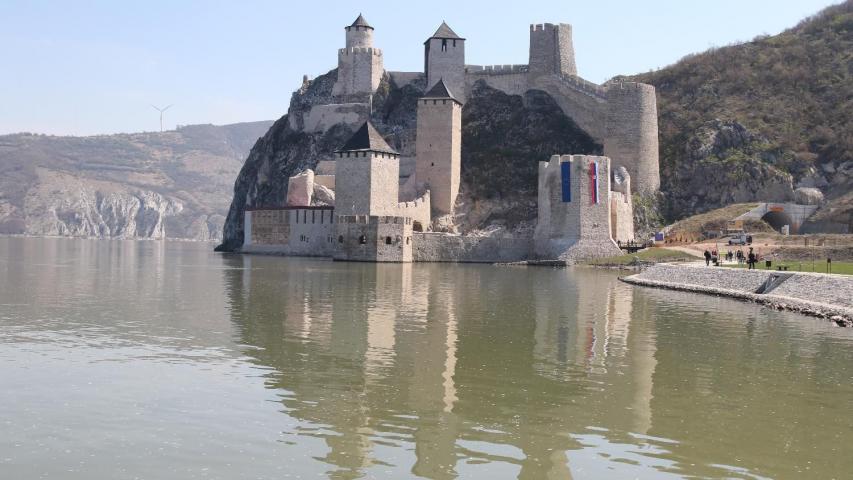Support our authors
DonateThe Lady who saved Sigismund’s life

The Lady who saved King Sigismund’s life
 The lady who saved King Sigismund’s life was Lady Cecille Rozgonyi. She came to the rescue of King Sigismund (1368-1437) in 1428. It happened during the siege of Galambóc / Golubac Castle.
The lady who saved King Sigismund’s life was Lady Cecille Rozgonyi. She came to the rescue of King Sigismund (1368-1437) in 1428. It happened during the siege of Galambóc / Golubac Castle.
Treason in 1428: the king was betrayed
Now, Galambóc (Голубац/Golubac, Taubenberg, Gögerdsinlik) is a settlement in Serbia. It was on a very important strategic position on the southern border of the Kingdom of Hungary in the age of Ottoman-Hungarian wars. It was located at the Irongate where the Danube flows through at its narrowest section. Whoever held that section of the Danube river, was in charge of the routes between the Balkans and Hungary. It was the center of conflicts between the Byzantinians and Bulgarians, Hungarians and Serbians and Turks.

King Sigismund of Hungary gained the castle by diplomacy. Serbian Despot Lázár Brankovics had made a contract with King Sigismund but the Despot died in 1427. According to the treaty, the Despots’men had to cede the Serbian forts at the Iron Gate to Hungary so as to stop the expanding Ottoman Empire.
Most sadly, the Serbian guards of Galambóc castle ignored this treaty. They sold the fort to the Turks for 12,000 pieces of gold in 1428. You can read more about Galambóc here:
https://www.hungarianottomanwars.com/ottoman-occupied-lands/galamboc/
King Sigismund fights back
 In answer to this, a castle was quickly built on the Hungarian side of the river. It was named after the Hungarian Saint László by King Sigismund himself who revered this knightly saint. Szentlászlóvár castle was ready in 1428 and the Hungarians attacked Galambóc from here.
In answer to this, a castle was quickly built on the Hungarian side of the river. It was named after the Hungarian Saint László by King Sigismund himself who revered this knightly saint. Szentlászlóvár castle was ready in 1428 and the Hungarians attacked Galambóc from here.
The king attacked Galambóc from Szentlászlóvár in April 1428. It was the first time in the history of the Hungarian military when they used artillery fire. Also, fierce river-battles were taking shape on the Danube. Sigismund had around 15,000–20,000 soldiers and his army also included Lithuanian and Wallachian auxiliary regiments. Their commanders were Zawisza Czarny and Dan II of Wallachia.
The Hungarian soldiers shelled the fortress from warships and from Szentlászlóvára castle. The Ottoman defenders of Galambóc resisted well, but the shelling destroyed the walls. Sigismund planned an assault against the walls when a significant Ottoman army, led personally by Sultan Murad II, arrived to save the fortress.
Sigismund did not engage the Sultan in an open battle and instead reached an armistice. The Christians were to stop their attacks and retreat in peace, although the siege was almost successful.
The Sultan breaks his promise
The Christian army started crossing the Danube in retreat when the Ottomans broke the truce and organized a surprise attack. During the battle, Sigismund’s guards were led by Rozgonyi István, Comes of Temes County.
Rozgonyi’s wife, Lady Cicelle personally organized the crossing of the Danube, bringing reinforcement by boats. She saved the king’s life who could narrowly escape on her boat. Allegedly, he had even fallen into the water and she had to fish him out. Lithuanian soldiers, including their commander, were killed while covering the crossing of Hungarian and Wallachian troops.
So it was how King Sigismund / Zsigmond was defeated in the battle of 12 June 1428. Having learned his lesson about facing the Ottomans in a grand-scale battle (Nicopolis 1396), King Sigismund / Zsigmond was doing his best to build out a strong defense system of castles. He sent a significant army to Nándorfehérvár / Belgrade castle right after the failure and focused on building out the southern chain of castles.
However, Sultan Murad II did not attack Hungary and instead concentrated on the siege of Thessalonica. In 1430 the Ottomans reached an armistice with Sigismund / Zsigmond, which held till 1432.
The king awarded the Rozgonyi family richly. As for Szentlászlóvár, the Teutonic Order took it over.
Their cannons made life miserable to the Turks in Galambóc castle that was a mile across the river.
You can read more about Hungarian-Ottoman wars here.
